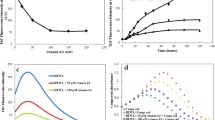Abstract
Protein aggregation occurs via a process in which unnatural molecules connect together and create soluble small oligomers or insoluble aggregations. The aggregation of protein depends on resistance conformation and the colloidal characteristics of proteins. Finding proper ways to stabilize or prevent of protein aggregation could be important for the control of such diseases as Alzheimer’s and Parkinson’s. Seidlitzia rosmarinus (S. rosmarinus) extract has antioxidant compounds which can cause an increase in protein resistance and prevent protein aggregation. The aim of this study is to assess the chaperone effects of compounds in S. rosmarinus extract on protein aggregation. In this research, the chaperone property of S. rosmarinus extract was evaluated on ovotransferin, insulin, and α-lactalbumin aggregation, using visible light spectroscopy, florescence and circular dichroism spectroscopy. The results indicate that the extract of S. rosmarinus could prevent protein aggregation in a concentration-dependent manner. The protective effect of S. rosmarinus, however, differed among the three proteins due to their different hydrophobic surface areas.




Similar content being viewed by others
Abbreviations
- S. rosmarinus :
-
(Seidlitzia rosmarinus)
- ANS:
-
1-Anilino-8-naphthalene sulfonic acid
- DTT:
-
1,4-dithiothreitol
- ThT:
-
(Thioflavin T)
- CD:
-
(Circular dichroism)
- Arg:
-
(Arginine)
- Gly:
-
(Glycine)
- Trp:
-
(tryptophan)
References
Bhattacharyya J, Santhoshkumar P, Sharma KK (2003) A peptide sequence Ysgvchtdlhawhgdwplpvk[40–60]-in yest alcohol dehydrogenase prevent the aggregation of denatured substrate proteins. Biochem Biophys Res Commun 307:1–7
Carver JA, Lindner RA, Lyon C, Canet D, Hernandez H, Dobson CM, Redfield C (2002) The interation of the molecular chaperone α-crystallin with unfolding α-lactalbumin: a structure and kinetic spectroscopic study. J Mol Biol 318:815–827
Chiti F, Dobson CM (2009) Amyloid formation by globular proteins under native conditions. Nat Chem Biol 5:15–22
Dobson CM (1999) Protein misfolding, evolution and disease. Trends Biochem Sci 24:329–332
Dobson CM (2001) The structural basis of protein folding and its links with human disease. Philos Trans R Soc B: Biol Sci 356:133–145
Eanes ED, Glenner GG (1968) X-ray diffractionstudies on amyloid filaments. J Histochem Cytochem 16:673–677
Ecroyd H, Carver JA (2008) The effect of small molecules in modulating the chaperone activity of aB-crystallin against ordered and disordered protein aggregation. FEBS J 275:935–947
Ehud G (2006) Inhibition of amyloid fibril formation by polyphenols: structural similarity and aromatic interactions as a common inhibition mechanism. Chem Biol Drug Des 67:27–37
Engel MF, Van Mierlo CP, Visser AJ (2002) Kinetic and structural characterization of adsorption-induced unfolding of bovine a-lactalbumin. J Biol Chem 277:10922–10930
Farahbakhsh ZT, Huang Q, Ding L, Altenbach C, Steinhoff H, Horwitz J, Hubbell WI (1995) Interaction of α-crystallin with spin-labeled peptide. Biochemistry 34:509–516
Freifelder D (1982) Physical biochemistry-applications to biochemistry and molecular biology. W. H. Freeman & Company Ltd, New York
Ghahghaei A, Divsalar A, Faridi N (2010) The effect of molecular crowding on the amyloid fibril formation of α-lactalbumin and the chaperone action of α-casein. Protein J 29:257–264
Ghahghaei A, Bathai SZ, Shahraki A, Rahmany Asgarabad F (2011) Comparison of the chaperoning action of glycerol and β-caseinon on aggregation of proteins in the presence of crowding agent. Int J Pept Res Ther 17:101–111
Hadi MR (2009) Biotechnological potentials of Seidlitzia rosmarinus: a mini review. Afr J Biotechnol 8:2429–2431
Hadi MR, Taheri R, Sharif MS (2007) Study effects of salinity on the seed germination of Seidlitzia rosmarinus. Pajouhesh va Sazandegi 67:151–157
Jafari M, ZareChahouki MA, Tavili A (2003) Azarniv and, soil-vegetation relationships in Hoz-e-Soltan region of Qom province. Iran Pak J Nut 2:329–334
Kelleher SL, Chatterton D, Nielsen K, Lonnerdal B (2003) Glycomacropeptide and lactalbumin supplementation of infant formula affect growth and nutritional status in infant rhesus monkeys. Am J Clin Nutr 77:1261–1268
Lindner RA, Kapur A, Mariani M, Titmuss SJ, Carver JA (1998) Structural alteration of α-crystallin during its chaperone action. Eur J Biochem 258:170–183
Liu R, Su R, Qi W, He Z (2011) Photo-induced inhibition of insulin amyloid fibrillation on online laser measurement. Biochem Biophys Res Commun 409:229–234
MacPhee CE, Treweek TM, Lindner RA, Price WE, Carver JA (2005) Casein proteins as molecular chaperones. J Agric Food Chem 53:2670–2683
Mizutani K, Yamashita H, Oe H, Hirose M (1997) Structural characteristics of the disulfide-reduced ovotransferrin N-lobe analysed by protein fragmentation. Biosci Biotechnol.Biochem 61:641–646
Sandhar HK, Kumar B, Prasher S, Tiwari P, Salhan M, Sharma P (2011) A review of phytochemistry and pharmacology of flavonoids. Int Pharm Sci 1:25–41
Sati SP, Singh SK, Kumar N, Sharma A (2002) Extra terminal residues have a profound effect on the folding and solubility of a plasmodium falciparum sexual stage-specific protein over expressed in Escherichia coli. Eur J Biochem 269:5259–5263
Semisotnov GV, Rodionova NA, Razgulyaev OI, Uversky VN, Gripas AF, Gilmanshin RI (1991) Study of the “molten globule” intermediate state in protein folding by a hydrophobic fluorescent probe. Biopolymers 31:119–128
Tapas AR, Sakarkar DM, Kakde RB (2008) Flavonoids as nutraceuticals: a review. Trop J Pharm Res 7:1089–1099
Timasheff SN, Ettinger MJ, Sterycharz GD (1971) Optical activity of insulin. I. On the nature of circular dichroism bands. Biochemistry 10:824–831
Uversky VN (2002) Natively unfolded proteins: a P0it where biology waits for physics. Protein Sci 11:739–756
Acknowledgments
This article dose not contain any studies with human and animal subjects performed by any of the authors. All authors (A. Heidari, A. Ghahghaei, and J. Valazadeh) declare that they have no conflict of interest. The authors are thankful to the university of Sistan and Baluchestan for providing necessary facilities.
Author information
Authors and Affiliations
Corresponding author
Rights and permissions
About this article
Cite this article
Heidari, A., Ghahghaei, A. & Valizadeh, J. Evaluation of chaperone ability of S. rosmarinus against protein aggregation. Journal of Pharmaceutical Investigation 44, 423–430 (2014). https://doi.org/10.1007/s40005-014-0136-1
Received:
Accepted:
Published:
Issue Date:
DOI: https://doi.org/10.1007/s40005-014-0136-1




